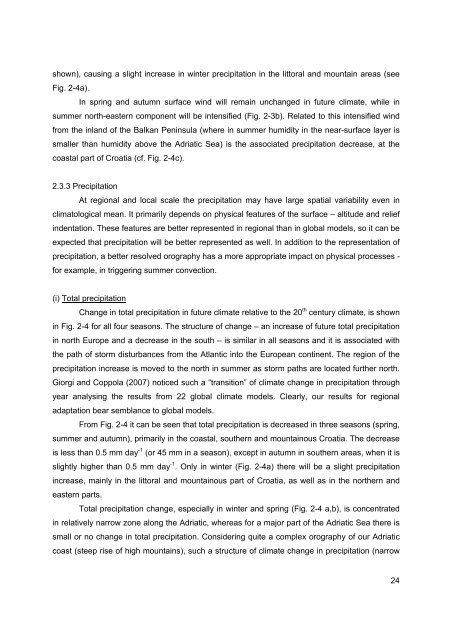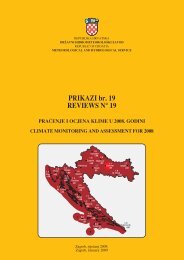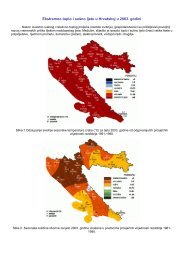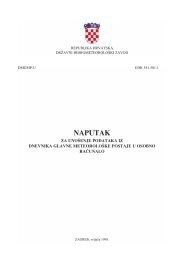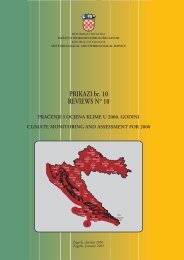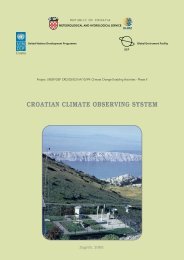Observed climate changes in Croatia Climate change scenario
Observed climate changes in Croatia Climate change scenario
Observed climate changes in Croatia Climate change scenario
You also want an ePaper? Increase the reach of your titles
YUMPU automatically turns print PDFs into web optimized ePapers that Google loves.
shown), caus<strong>in</strong>g a slight <strong>in</strong>crease <strong>in</strong> w<strong>in</strong>ter precipitation <strong>in</strong> the littoral and mounta<strong>in</strong> areas (see<br />
Fig. 2-4a).<br />
In spr<strong>in</strong>g and autumn surface w<strong>in</strong>d will rema<strong>in</strong> un<strong>change</strong>d <strong>in</strong> future <strong>climate</strong>, while <strong>in</strong><br />
summer north-eastern component will be <strong>in</strong>tensified (Fig. 2-3b). Related to this <strong>in</strong>tensified w<strong>in</strong>d<br />
from the <strong>in</strong>land of the Balkan Pen<strong>in</strong>sula (where <strong>in</strong> summer humidity <strong>in</strong> the near-surface layer is<br />
smaller than humidity above the Adriatic Sea) is the associated precipitation decrease, at the<br />
coastal part of <strong>Croatia</strong> (cf. Fig. 2-4c).<br />
2.3.3 Precipitation<br />
At regional and local scale the precipitation may have large spatial variability even <strong>in</strong><br />
climatological mean. It primarily depends on physical features of the surface – altitude and relief<br />
<strong>in</strong>dentation. These features are better represented <strong>in</strong> regional than <strong>in</strong> global models, so it can be<br />
expected that precipitation will be better represented as well. In addition to the representation of<br />
precipitation, a better resolved orography has a more appropriate impact on physical processes -<br />
for example, <strong>in</strong> trigger<strong>in</strong>g summer convection.<br />
(i) Total precipitation<br />
Change <strong>in</strong> total precipitation <strong>in</strong> future <strong>climate</strong> relative to the 20 th century <strong>climate</strong>, is shown<br />
<strong>in</strong> Fig. 2-4 for all four seasons. The structure of <strong>change</strong> – an <strong>in</strong>crease of future total precipitation<br />
<strong>in</strong> north Europe and a decrease <strong>in</strong> the south – is similar <strong>in</strong> all seasons and it is associated with<br />
the path of storm disturbances from the Atlantic <strong>in</strong>to the European cont<strong>in</strong>ent. The region of the<br />
precipitation <strong>in</strong>crease is moved to the north <strong>in</strong> summer as storm paths are located further north.<br />
Giorgi and Coppola (2007) noticed such a “transition” of <strong>climate</strong> <strong>change</strong> <strong>in</strong> precipitation through<br />
year analys<strong>in</strong>g the results from 22 global <strong>climate</strong> models. Clearly, our results for regional<br />
adaptation bear semblance to global models.<br />
From Fig. 2-4 it can be seen that total precipitation is decreased <strong>in</strong> three seasons (spr<strong>in</strong>g,<br />
summer and autumn), primarily <strong>in</strong> the coastal, southern and mounta<strong>in</strong>ous <strong>Croatia</strong>. The decrease<br />
is less than 0.5 mm day -1 (or 45 mm <strong>in</strong> a season), except <strong>in</strong> autumn <strong>in</strong> southern areas, when it is<br />
slightly higher than 0.5 mm day -1 . Only <strong>in</strong> w<strong>in</strong>ter (Fig. 2-4a) there will be a slight precipitation<br />
<strong>in</strong>crease, ma<strong>in</strong>ly <strong>in</strong> the littoral and mounta<strong>in</strong>ous part of <strong>Croatia</strong>, as well as <strong>in</strong> the northern and<br />
eastern parts.<br />
Total precipitation <strong>change</strong>, especially <strong>in</strong> w<strong>in</strong>ter and spr<strong>in</strong>g (Fig. 2-4 a,b), is concentrated<br />
<strong>in</strong> relatively narrow zone along the Adriatic, whereas for a major part of the Adriatic Sea there is<br />
small or no <strong>change</strong> <strong>in</strong> total precipitation. Consider<strong>in</strong>g quite a complex orography of our Adriatic<br />
coast (steep rise of high mounta<strong>in</strong>s), such a structure of <strong>climate</strong> <strong>change</strong> <strong>in</strong> precipitation (narrow<br />
24


